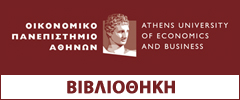| Abstract : | Ο σκοπός της παρούσας διπλωματικής είναι η δημιουργία ενός βραχυχρονίου μοντέλου παλινδρόμησης με γεφυρωμένη λειτουργεία. Ο απώτερος στόχος είναι να αξιοποιήσουμε τα δεδομένα που ανακοινώνονται σε μηναία βάση ώστε να προβλέψουμε μεταβλητές μακράς χρονικής διάρκειας, όπως ακαθάριστο εθνικό προϊόν. Ως γνωστόν, οι συσχετίσεις μεταξύ παραγόντων και δεικτών μέσα σε μια διαρκώς αναπτυσσόμενη οικονομία μεταβάλλονται συχνά, συνεπώς μέσα στο πλαίσιο της νέας πραγματικότητας, και ειδικότερα της εξάπλωσης του κορονοϊό, έχει ενδιαφέρον να εξετάσουμε την δημιουργία αυτού του τύπου μοντέλου για την πρόβλεψη του ΑΕΠ. Το αρχικό μοντέλο που δημιουργήσαμε, με τρεις ανεξάρτητους μεταβλητές, λειτούργησε ικανοποιητικά ωστόσο παρατηρήθηκε ότι όταν προσθέσαμε μεταβλητές σχετιζόμενους με την επέκταση του κορονοϊού, όπως ο αριθμός των καθημερινών κρουσμάτων, το μοντέλο εμφάνισε πιο ισχυρά στατιστικά δεδομένα. Σε μια προσπάθεια να εμβαθύνουμε την ανάλυση και να ξεπεράσουμε τα μέχρι τώρα δεδομένα αναφορικά με την υπάρχουσα βιβλιογραφία, εξετάσαμε και την δημιουργία μοντέλου γεφυρωμένης λειτουργίας με στοιχεία συ σχετιζόμενα με το χρηματιστήριο Αθηνών, όπως εν παραδείγματι με τις τιμές ομολόγων, την απόδοση ομολόγων κλπ. Το μοντέλο που δημιουργήθηκε ενώ υπέδειξε αξιόλογα στοιχεία απόδοσης συγκριτικά ήταν πιο αδύναμο από τα προηγούμενα εξεταζόμενα μοντέλα. Στην συνεχιζόμενη ανάλυση εξετάσαμε και εμπράκτως τις ικανότητες πρόβλεψης των δυο προεπιλεγμένων μοντέλων σε μια πραγματική εξάσκηση πρόβλεψης τύπου Τ+1 και Τ+2, περιόδους. Τα αποτελέσματα, και πάλι, ήταν ικανοποιητικά και σαφώς καλύτερα από τις υπάρχουσες προβλέψεις τις αγοράς. Ειδικότερα όμως, παρατηρήθηκε ότι όταν ανανεώσαμε το εξεταζόμενο μοντέλο με τα νέα οικονομικά δεδομένα της αγοράς, από την ΕΛΣΤΑΤ, το μοντέλο απέδωσε με μεγαλύτερη ακρίβεια.
The main scope of this thesis is to primarily construct a bridge model for GDP nowcasting purposes, in the mist of the coronavirus pandemic spread. Such models have been applied extensively in the past with the intent of linking highly to low frequency data, as in the case with GDP projections. However, as the financial environments, and overall structures, evolve there is always a constant need to re-examine relationship dynamics and to assess whether, or not, newly independent variables constitute meaningful predictors. On the grounds of this concept I will re-evaluate past relationships and further expand into new horizons to develop an ideal nowcast model. Upon the assessment procedure the initial selected parsimonious model performed quite satisfactorily, and improved its predictive capacity when I added three coronavirus related independent variables. In this instance, its error metrics were significantly improved, as with its overall performance, such as its adjusted R squared and its Akaike information criterion value. However, a significant limitation of this model involves the restricted amount of data point differences of the newly added variables, as they become available after the first quarter of 2020. Despite this issue, however, these indicators are considered consequential regressors since they manage to correctly adjust the slope of the regression model, which is seen from the model’s real-time pseudo analysis performance. In an attempt to examine a more financially related model, with a direct link to the Greek stock market behavior, beyond the scope of current bridge model literature, I utilized strictly financial indicators, such as bond yields, bond spreads etc., the results were adequate, however were deemed less efficient when compared to the previously constructed models. Finally, to examine the predictive capabilities of the most efficient models, I evaluated a T+1 and T+2 nowcast projection against the actual GDP values for the first and second quarter of 2022. The issue here was to perform two types of projections as to update the regression models with contemporaneous information against those that did not include updated information. It was proven that the later performed exceptionally well, but lagged in comparison with the continuously updated models.
|
|---|







 Copyright © 2013 Library AUEB. All rights reserved.
Copyright © 2013 Library AUEB. All rights reserved.